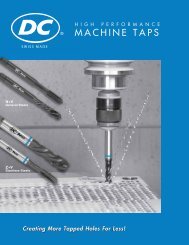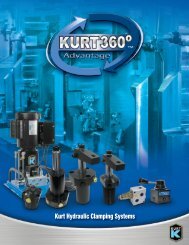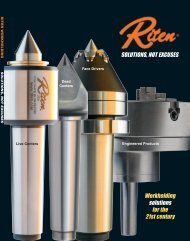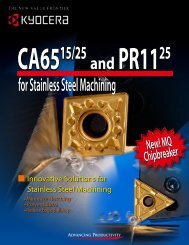VS - Machinery Canada
VS - Machinery Canada
VS - Machinery Canada
You also want an ePaper? Increase the reach of your titles
YUMPU automatically turns print PDFs into web optimized ePapers that Google loves.
CROWN TAPS<br />
General information<br />
The DC crown tap with ”V” surface treatment to prevent cold<br />
welding is a tool of high performance, which offers a very high<br />
quality surface finish of the tapped threads.<br />
Application rang<br />
Thanks to the front recess providing space for the chip collection,<br />
the DC crown tap is suitable for both, through and blind<br />
hole tapping. The crown tap can be used for materials with a<br />
tensile strength up to 850 N/mm 2 and an elongation of maximum<br />
30 %.<br />
Utilization<br />
The crown tap can be used for through holes of any depth. However,<br />
for an optimal blind hole threading, the core hole depth<br />
must be adapted accordingly and the following application<br />
instructions must be followed:<br />
- Tap until tapping head clutch slips<br />
- Retract tap and clear chips<br />
- Tap to the full depth.<br />
General hints<br />
The efficient operation of DC crown taps, as well as the quality<br />
of the cut threads, depend on observation of the following<br />
rules:<br />
- Do not exceed the maximum permissible centering error<br />
of 0.1 mm<br />
- The tap must run concentrically, use a suitable tapping head<br />
- Tap at the correct cutting speed<br />
- Select a coolant to suit the material being tapped<br />
- Use a tapping head with axial compensation and safety<br />
clutch<br />
- Set the safety clutch so that it will slip at just above the<br />
tapping torque.<br />
When tapping the first hole, slacken the clutch until it slips, then<br />
gradually tighten it until the tap is driven.<br />
Chip accumulation<br />
The chip accumulation capacity of the recess is the following :<br />
Thread diameter Ø 20 - 29 mm > Ø 30 mm<br />
M - 1.4 x D<br />
MF 1.2 x D 1.4 x D<br />
UN-8 - 1.4 x D<br />
G 1.2 x D 1.4 x D<br />
MACHO DE CORONA<br />
Generalidad<br />
El macho de corona DC con tratamiento superficial ”V” es un útil<br />
de alto rendimiento que realiza tolerancias de rosca precisas y<br />
una calidad superficial del roscado particularmente buena.<br />
Campos de aplicación<br />
El ahuecamiento delantero permite alojar las virutas. Por esta<br />
razón, el macho de corona puede ser utilizado tanto en agujeros<br />
pasantes como en agujeros ciegos. Su campo de aplicación<br />
se situa para materiales con resistencia hasta 850 N/mm 2 y<br />
alargamiento máximo a la rotura de 30 %.<br />
Utilización<br />
El macho de corona DC puede ser utilizado para todas las profundidades<br />
de roscados en agujeros pasantes. En caso de agujeros<br />
ciegos, para un roscado correcto, hay que adaptar la profundidad<br />
del taladro previo y seguir las siguientes instrucciones :<br />
- roscar hasta que la fricción del aparato de roscar patine<br />
- retroceder el macho y quitar las virutas<br />
- terminar de roscar hasta el fondo de agujero.<br />
Exigencias particulares<br />
El funcionamiento correcto del macho de corona DC, así como<br />
la calidad de la rosca, dependen de los puntos siguientes :<br />
- el error de alineación no debe exceder 0.1 mm<br />
- el macho debe girar perfectamente centrado, utilizar un<br />
porta-machos de roscar adecuado<br />
- trabajar con una velocidad de corte correcta<br />
- lubrificante adaptado al material<br />
- fijar el útil en un aparato de roscar con compensación<br />
axial y embrague de seguridad<br />
- reglar el embrague de seguridad sobre una posición superior<br />
al par de potencia de trabajo.<br />
En el momento del primer roscado, aflojar el embrague, y<br />
apretar progresivamente hasta que el macho entre en movimiento.<br />
Virutas<br />
La capacidad de acumulación de las virutas en el ahuecamiento<br />
es la siguiente :<br />
Roscas Ø 20 - 29 mm ≥ Ø 30 mm<br />
M - 1.4 x D<br />
MF 1.2 x D 1.4 x D<br />
UN-8 - 1.4 x D<br />
G 1.2 x D 1.4 x D<br />
Cutting and spindle speeds (guide values) - Velocidad de corte y revoluciones por minuto (directivas)<br />
M P Vc n<br />
(m/min) (U/min)<br />
MF P Vc n<br />
(m/min) (U/min)<br />
MF P Vc n<br />
(m/min) (U/min)<br />
UN-8 P Vc n<br />
TPI (m/min) (U/min)<br />
30 3.5 7.9 84<br />
33 3.5 7.7 74<br />
36 4.0 7.5 66<br />
39 4.0 7.3 60<br />
42 4.5 7.1 54<br />
45 4.5 6.9 49<br />
48 5.0 6.6 44<br />
52 5.0 6.4 39<br />
56 5.5 6.1 35<br />
60 5.5 5.8 31<br />
64 6.0 5.5 28<br />
68 6.0 5.2 25<br />
22 1.5 8.0 116<br />
24 1.5 8.0 106<br />
26 1.5 7.9 97<br />
28 1.5 7.9 90<br />
30 1.5 7.9 84<br />
30 2.0 7.9 84<br />
32 1.5 7.8 77<br />
32 2.0 7.8 77<br />
33 1.5 7.7 74<br />
33 2.0 7.7 74<br />
34 1.5 7.6 71<br />
35 1.5 7.6 69<br />
36 1.5 7.5 66<br />
36 2.0 7.5 66<br />
36 3.0 7.5 66<br />
38 1.5 7.3 62<br />
40 1.5 7.2 57<br />
40 2.0 7.2 57<br />
42 1.5 7.1 54<br />
42 2.0 7.1 54<br />
42 3.0 7.1 54<br />
42 4.0 7.1 54<br />
45 1.5 6.9 49<br />
45 2.0 6.9 49<br />
48 1.5 6.6 44<br />
48 2.0 6.6 44<br />
48 3.0 6.6 44<br />
48 4.0 6.6 44<br />
50 1.5 6.5 41<br />
52 1.5 6.4 39<br />
52 3.0 6.4 39<br />
55 1.5 6.2 36<br />
56 4.0 6.1 35<br />
60 2.0 5.8 31<br />
64 4.0 5.5 28<br />
68 4.0 5.2 25<br />
72 6.0 5.0 22<br />
76 6.0 4.7 20<br />
80 2.0 4.4 18<br />
80 4.0 4.4 18<br />
80 6.0 4.4 18<br />
90 6.0 3.7 13<br />
100 6.0 3.0 10<br />
110 6.0 2.5 7<br />
1 1 /4” 8.0 7.8 77<br />
1 3 /8” 8.0 7.6 69<br />
1 1 /2” 8.0 7.3 62<br />
1 5 /8” 8.0 7.1 55<br />
1 3 /4” 8.0 6.9 49<br />
1 7 /8” 8.0 6.7 45<br />
2” 8.0 6.4 40<br />
G P Vc n<br />
TPI (m/min) (U/min)<br />
1” 11.0 7.7 74<br />
1 1 /4” 11.0 7.1 54<br />
1 1 /2” 11.0 6.6 44<br />
2” 11.0 5.8 31<br />
2 1 /4” 11.0 5.4 26<br />
2 1 /2” 11.0 4.8 20<br />
2 3 /4” 11.0 4.3 17<br />
3” 11.0 3.8 14<br />
THREADING<br />
TECHNOLOGY<br />
183









